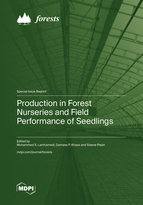Production in Forest Nurseries and Field Performance of Seedlings
A special issue of Forests (ISSN 1999-4907). This special issue belongs to the section "Forest Ecology and Management".
Deadline for manuscript submissions: closed (10 April 2023) | Viewed by 21445
Special Issue Editors
Interests: forest nursery; ecophysiology; cultural practices; composting and growing media; environmental stress; vegetative propagation; genetic of ectomycorrhizal fungi; assisted migration; heavy metal tolerance; seedling performance
Special Issues, Collections and Topics in MDPI journals
Interests: biotechnologies of mycorrhizal and nitrogen-fixing symbioses; nursery production; molecular ecology and environmental genomics; agroforestry; mining restoration; invasive plant biology; field performance
Special Issues, Collections and Topics in MDPI journals
Interests: tree physiology; gas exchange; soil–plant interactions; environmental biophysics; irrigation; microclimate; peat substrate properties
Special Issues, Collections and Topics in MDPI journals
Special Issue Information
Dear Colleagues,
The success of the various reforestation programs (production, protection, recreation, agroforestry, combating desertification, etc.) is a major challenge which requires optimization and control of the various steps in the production chain of seedlings of high morphophysiological quality, from seed or cutting or emblings to planting. The establishment, survival, and growth of seedlings in reforestation sites are closely linked to the different cultural practices in nurseries and silvicultural techniques in reforestation sites. In the context of climate change, seedlings and plantations are subject to different environmental stresses and some very severe climatic extremes that negatively affect their survival and growth.
Thus, the morphophysiological quality of seedlings is one of the essential components that directly affects the success of reforestation programs. The production of quality seedlings or emblings in forest nurseries and the success of plantations are strongly linked to the selection of genetic sources (provenance, families, clones) adapted to the plantation sites, to the different cultural practices applied in the nursery, to the handling, transportation, and storage of seedlings or emblings before planting them on a reforestation site, site preparation, and silvicultural techniques.
This Special Issue will integrate original research, practical strategies, and reviews related to but not limited to the following potential topics:
(a) Genetic material and seed quality, growth and physiology of seedlings produced by somatic embryogenesis, cutting, seeds, and other propagation techniques;
(b) Production in forest nurseries and effects of different practical techniques on the morphophysiological quality of seedlings or emblings: containers, and seedling size, physicochemical properties of different growing media, management of water and fertilizers, mineral nutrient leaching, water stress preconditioning, ecophysiology of seedlings or stecklings, frost and water stress tolerance, short-day treatment, hardening and dehardening; seedling or embling storage; mycorrhizal fungi and other symbioses, etc.;
(c) Field performance of seedlings or emblings under different site conditions, handling and transportation, assignment of the genetic characteristics of seedlings to the conditions of the planting site and the current and future climate, assisted migration, competing vegetation, site preparation techniques and silvicultural treatments, growth and physiology of seedlings or emblings in response to different environmental stress conditions (drought, salinity, heavy metal, frost, etc.).
Dr. Mohammed S. Lamhamedi
Prof. Dr. Damase P. Khasa
Prof. Dr. Steeve Pepin
Guest Editors
Manuscript Submission Information
Manuscripts should be submitted online at www.mdpi.com by registering and logging in to this website. Once you are registered, click here to go to the submission form. Manuscripts can be submitted until the deadline. All submissions that pass pre-check are peer-reviewed. Accepted papers will be published continuously in the journal (as soon as accepted) and will be listed together on the special issue website. Research articles, review articles as well as short communications are invited. For planned papers, a title and short abstract (about 100 words) can be sent to the Editorial Office for announcement on this website.
Submitted manuscripts should not have been published previously, nor be under consideration for publication elsewhere (except conference proceedings papers). All manuscripts are thoroughly refereed through a single-blind peer-review process. A guide for authors and other relevant information for submission of manuscripts is available on the Instructions for Authors page. Forests is an international peer-reviewed open access monthly journal published by MDPI.
Please visit the Instructions for Authors page before submitting a manuscript. The Article Processing Charge (APC) for publication in this open access journal is 2600 CHF (Swiss Francs). Submitted papers should be well formatted and use good English. Authors may use MDPI's English editing service prior to publication or during author revisions.
Keywords
- seed and seedling quality
- cutting
- somatic embryogenesis
- nursery production
- cultural practices
- environmental stress
- mycorrhizal and bacteria symbioses
- field performance






